Southampton Corporation
Southampton Corporation
Southampton Corporation was one of the few operators to be tempted by the pre war Guy Arab, taking a total of eleven between 1934 and 1936. They proved to be sound purchases, remaining in service with the Corporation for 14 to 16 years. After the Guys, Southampton standardised on Leyland TD4 and TD5 Titans, and, but for the war, might well have stayed with Leyland. Under wartime controls, Southampton was obliged to renew its acquaintanceship with Guy products by taking 8 Arab IIs in 1944, and then, clearly satisfied with these machines, took a further 42 in the years between 1946 and 1948. By this time the Arab III was in production and the Corporation became a confirmed customer for this model, receiving no less than 149 up to 1954. Six dual entrance Arab UF saloons arrived in 1952, and six more of the same type appeared in 1955 - these were newly bodied on chassis that had been stored since 1952. Four of the latter batch had the second doorway removed in 1964, and were the last of this type in service with Southampton. In 1954 Percival Baker retired from the post of Transport Manager, and his successor, Gilbert Armstrong, took a different approach to new bus purchases. The complete post war replacement of the double deck fleet meant that no new 'deckers were required until 1961. The Corporation had maintained a remarkable loyalty towards Park Royal bodywork since the 1930s, and, apart from three of the 1944 Arab IIs which carried Weymann bodies, had remained wholly committed to this coachbuilder since 1933. In 1961 Park Royal supplied the bodies for twelve Leyland PD2s, but the ungainly styling of these buses provoked outspoken criticism. For the next three years, Southampton then wavered between the PD2 and the AEC Regent V, both types carrying Park Royal bodywork. The choice came down decisively upon the Regent V, but the gawky Park Royal body design was rejected in favour of the much higher quality East Lancs product. Subsequent Regent V deliveries mostly had the Neepsend version of the East Lancs design. On the single deck front, apart from a trio of Albion Nimbus in 1956/7, the next standard saloon between 1967 and 1969 was the AEC Swift with, initially, Strachan bodywork, and then East Lancs. Like several other operators dissatisfied with the single deck offerings of the Leyland stable, Southampton tried the Pennine bodied Seddon RU in 1972, but, as elsewhere, it proved to be decidedly disappointing. All five were gone within nine years. With the advent of the bus grant era, Southampton turned in large numbers to the Leyland Atlantean in its successive forms, but stayed with East Lancs to the end. After 1982, the Corporation vacillated between the Dennis Dominator and the Leyland Olympian until the destructive Ridley Transport Act erased municipal operation from the streets of Southampton after almost 90 years. A comprehensive history of this operator, with links to tram and bus fleet lists, may be found here:- Peter Goulds Southampton Corporation History
Roger Cox
03/2013
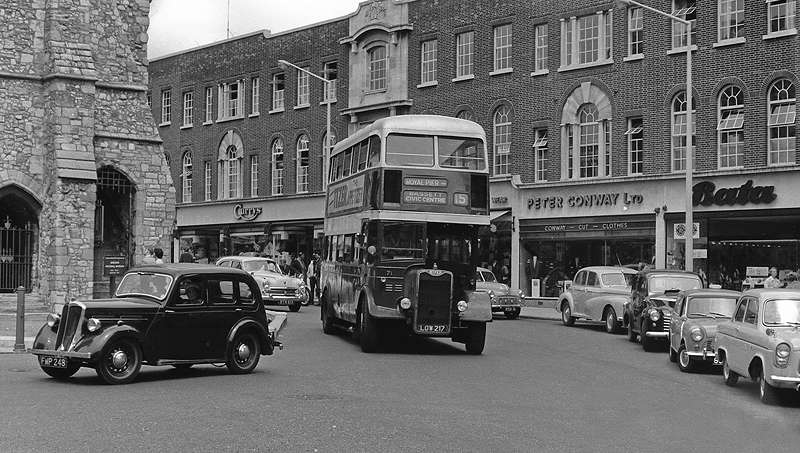
Guy Arab III No.71, LOW 217 with Park Royal H30/26R body is rounding the distinctive Bargate in 1961. This bus was one of the final batch of Arab IIIs that arrived in 1954. I have left this photo largely uncropped to show the contemporary private cars, notably the Flying Standard 10 that dated from 1937. The 10 year MOT test introduced in 1960 soon saw off many of the pre war private cars such as this. Arab No.71 lasted until 1975 in the Southampton fleet and is now preserved. This part of Southampton around the Bargate has since been pedestrianised.
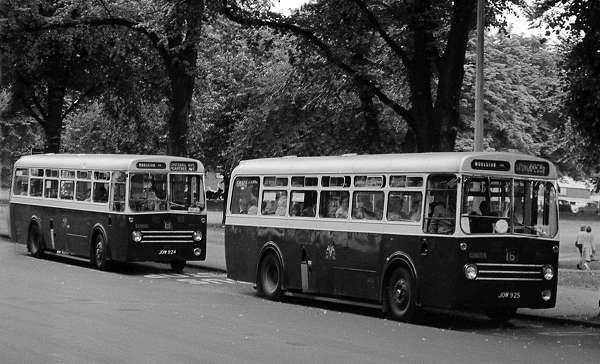
Fleet Nos.251/2, JOW 924/5, two of the Guy Arab UF saloons with chassis dating from 1952, but not fitted with bodies until 1955, are seen in Pound Tree Road. This 1961 picture shows them as originally built, when the Park Royal bodies were of B36D configuration. No. 251 remained in service until 1973, but fellow bus 252 was withdrawn in 1968.
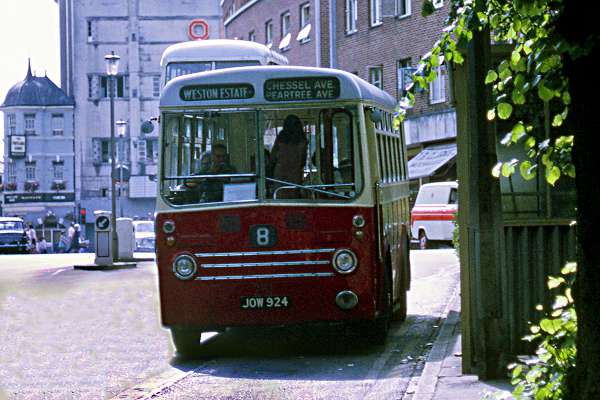
Two more shots of Arab UF No.251 taken in May 1968 show it in its later form after the second door was removed in 1964 and the capacity increased to B39F.
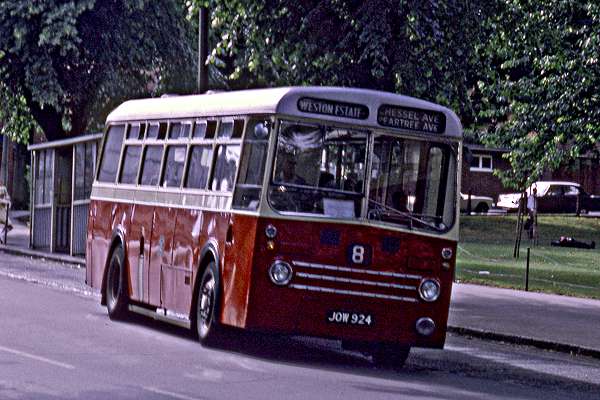
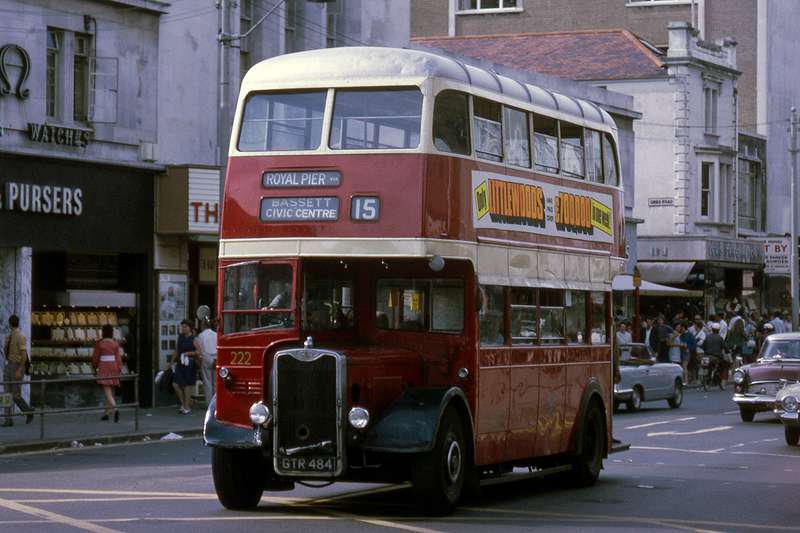
The classic combination of the Guy Arab III with Park Royal H30/26R body remains one of my favourite buses of all time. Though I have travelled many miles on Guy Arabs in Southampton and elsewhere as a passenger, I have, sadly, never driven one. Here is No.222, GTR 484, a 1951 bus, in Above Bar Street in May 1969. It is thought that this bus still survives. This part of Southampton was then a busy shopping area, but nowadays looks decidedly careworn.
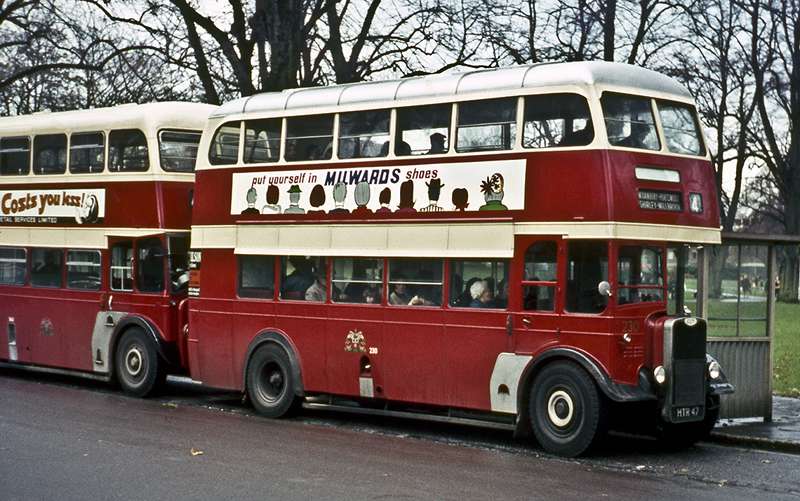
Another 1951 Arab III, No.230, HTR 47, is seen in Pound Tree Road in May 1969. Behind is Neepsend H37/29R bodied AEC Regent V 2D3RA No.363, BTR 363B of 1964.
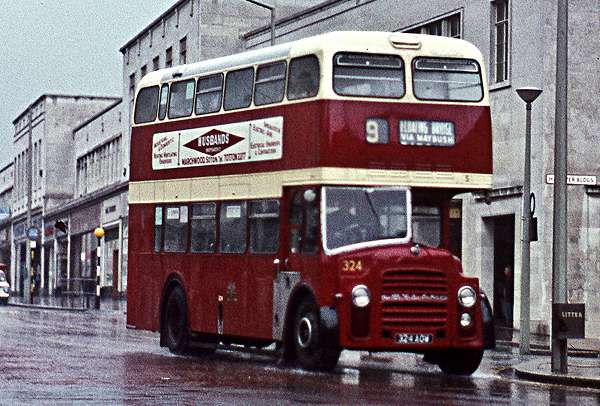
Saturday 25 June 1967 was a day of torrential rain in Southampton. Here is No. 324, 324 AOW, one of the Leyland PD2A/27 buses of 1962 with Park Royal H37/29R bodies. This ungainly offering from Park Royal finally put an end to the Corporation's long and loyal association with this coachbuilder after 33 years. From 1962/63, Southampton switched its allegiance to AEC and East Lancashire, though, in practice, most of the Regent V bodies emerged from the Neepsend factory.
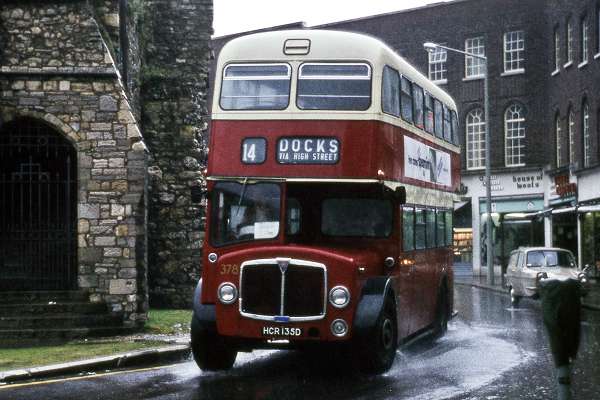
Also seen on 25 June 1967 is AEC Regent V 3D2RA No.378, HCR 135D, Neepsend H40/30R, rounding the Bargate. This is a 1966 bus, the year in which the Corporation altered its transmission preference for Regent Vs from Monocontrol to clutch and synchromesh gearbox.
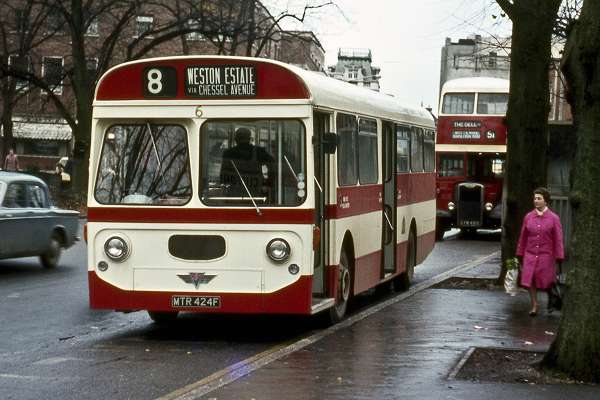
After the Arab UFs and a trio of Albion Nimbuses, Southampton turned to the AEC Swift for its single deck requirements. One was delivered in 1967, and five more in 1968. These had Strachan B47D bodies, which proved, with several operators, to be less prone to structural weakness than the bodywork of some other manufacturers on rear engined bus chassis. Seen in Pound Tree Road, this is No.6, MTR 424F, an example of the MP2R Swift, 36 feet long with the AH 505 engine and Monocontrol transmission. The bus behind is another of the many Arab IIIs, No.227, GTR 489 of 1951. A further four Swifts with East Lancs bodies were delivered in 1969, and pictures of one of these may be found elsewhere on this site (Southampton Corporation - AEC Swift - TCR 293H - 7).
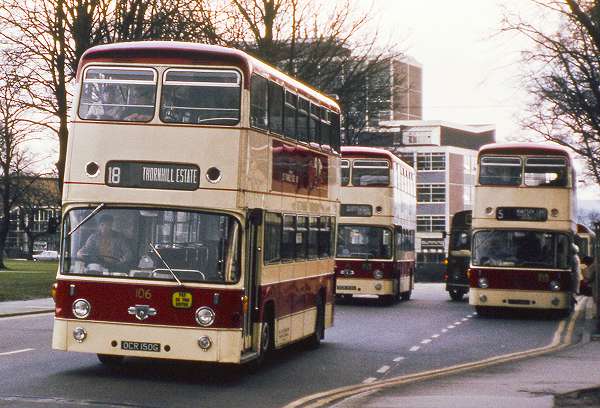
Southampton's preferred choice in the rear engined double deck field was the Leyland Atlantean, taking many examples of initially the PDR1/1, then PDR1A/1 and then finally the AN68. Here, in May 1970, is a group of three PDR1/1 Atlanteans led by No.106, OCR 150G of 1968 with East Lancs H45/31F bodywork.
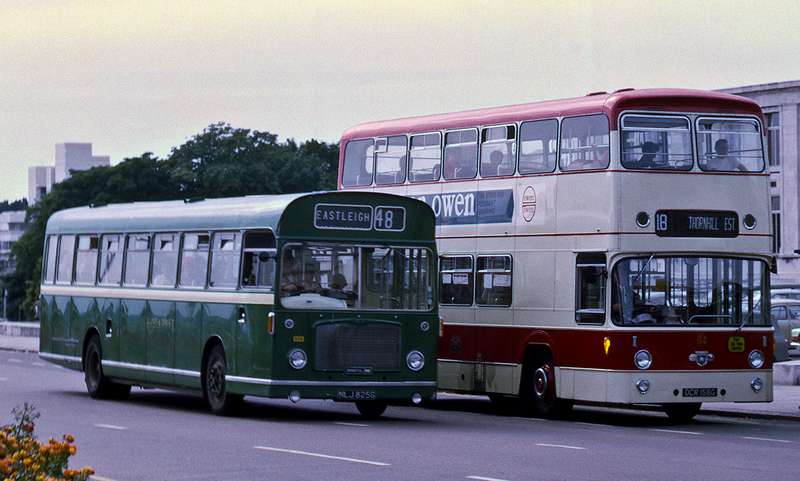
Again in May 1970, Atlantean PDR1/1 of 1968 No.114, OCR 158G is being overtaken by Hants and Dorset Bristol RELL6G No.836, NLJ 825G, also of 1968. This RE was later converted to carry a glider, and may possibly still exist today.
08/03/13 - 14:13
Excellent production, as always, Roger!
Pete Davies
08/03/13 - 16:10
Great gallery of an operator which I got to know from 1966 onwards. I notice you avoided posting a pic of Southampton's greatest embarrassment, The Park Royal PD2s!
As a True Northerner it was good to see so many products of Leyland and Blackburn on the streets from my earliest visits and once the Atlanteans arrived, half closing my eyes, I could imagine I was back in Bolton at the time I lived there and had to visit Southampton !!!
Seriously, the department had an interesting fleet and with other fleets serving the area visits there were always full of interest.
Phil Blinkhorn
08/03/13 - 16:23
Splendid gallery indeed but I think you must have had your eyes half-closed, Phil. Half-way down, large as life and twice as ugly is a PD2A/Park Royal. You obviously didn't want to see one among the other gems.....
David Oldfield
08/03/13 - 17:59
Old age David, but not failing eyesight, bad editing/proof reading. Should have said first batch of PD2s - as I featured on the Ugly Bus Page.
Phil Blinkhorn
08/03/13 - 18:11
Ah.....
David Oldfield
08/03/13 - 18:31
Roger. The shot of 71 is a brilliant bit of B&W photography - but is that Cave-Brown-Cave cooling vents on the bus? Since Cave-Brown-Cave was at Southampton University, does this make 71 an experimental prototype?
David Oldfield
09/03/13 - 07:39
In answer to David's question about Cave-Brown-Cave cooling/heating, it is true that Southampton Arabs were some of the first buses to be fitted, but 71 was not unique, another fitted was 234 (HTR 51), and I believe there were others. They were not fitted with Cave-Brown-Cave systems from new, they were retro-fitted.
In correction of a rare mistake from Roger, I can assure you that Regent V 378 was actually a 3D2RA (i.e. Monocontrol), and that 1966 was the year that Southampton changed from manual Regent Vs to Monocontrol, rather than the other way round.
David Call
09/03/13 - 07:39
I know nothing about Southampton Corporation apart from pictures I've seen but I was fortunate enough to travel on one of the Guy Arab UF saloons after they left Southampton. The Green Bus Company of Rugeley had at least two, JOW 920 and 922 and I remember thinking what wonderful machines they were. The rear doors had been removed but the interior door bulkheads remained, something I'd never encountered before and when I sat at the back, it was a bit like being in a compartment of your own. Did they have pre-selector gearboxes? I still remember all sorts of horrible (and frightening) noises coming from the gear box and I've often wondered if I was being driven under the misapprehension that it had a manual box.
Chris Barker
09/03/13 - 09:25
I'm now a very worried man. Both the Peter Gould fleet list and the 'Bus Lists On The Web' site give Southampton's pre-1966 Regent Vs as 2D3RA (manual) and 1966 onwards as 3D2RA (Monocontrol) - but neither site is infallible, and Southampton wouldn't have been the first operator to change from two-pedal to manual (Southdown, Preston, Bradford and Ramsbottom spring immediately to mind). Having said that, Southampton's PD2s are given as PD2/27 and PD2A/27 (manual, air brakes). Anyone any first-hand knowledge?
David Call
09/03/13 - 15:54
Thanks for the splendid gallery, Roger. One day in the mid/late 60s I rode on a couple of ex-So'ton UFs at Gainsborough--- or was it Brigg? If my poor colour memory is not hopelessly mistaken they were a deepish red and yellow or cream, and the operator's name consisted of two initials. The alarming noises from down below that Chris Barker mentioned must have been lack of concord among the cogs during gearchanges, because the boxes were manual but rather out of driver earshot. I remember the indirect gears as being every bit as musical as on the Arab IV. A most enjoyable couple of rides.
Can anyone fill in the details I'm so vague about?
One ex-So'ton UF is under resoration at Medstead, by the Watercress Line station.
Ian Thompson
09/03/13 - 16:39
David, you are correct. The Regent V orders changed from 3 pedal to 2 pedal - synchromesh to Monocontrol, not the other way round as I initially and wrongly stated. You can't get away with mistakes for long on OBP!
Glad to learn, Ian, that one of the UFs is still around. Like all Guys of the period, they were soundly engineered buses. Geoff Hilditch (yes, him again!) said that he knew of fleets of double deck Arabs where the daily availability figure ran at 98%. Modern day transport engineers would drool at such a figure.
Roger Cox
09/03/13 - 16:40
A nice set of pictures Roger. I particularly appreciate the first one and am glad you did not crop out the surrounding vehicles.
I presume that Park Royal's Arab single deck design was unique to Southampton, with those unusually (for the period) deep windows.
John Stringer
12/03/13 - 15:00
There is some discussion above about both the identity of the first Monocontrol Regent V and the Cave-Brown-Cave system. I've been looking through my copy of 'Southampton City Transport' by A K MacFarlane-Watt (TPC, 1977) There is an appendix relating to the CBC with photographs of Arab III 162 (FTR 509) which was the experimental vehicle. The fleet list notes that 373 (FOW 378D) was the first of the longer and Monocontrol Regent V fleet.
Pete Davies
13/03/13 - 06:39
In the early 1970's a former Southampton Guy, in
original livery, was used to transport staff from the
Salisbury General Infirmary in Fisherton Street to
Odstock Hospital on the outskirts of the City.
Unfortunately I cannot identify it.
Paragon
13/03/13 - 11:04
John Stringer comments that the Park Royal saloons on Guy Arab UF chassis were of unique design. I am not sure, but I think Swindon had several very similar saloons delivered within a year or so either way. These were on the rare Daimler Freeline chassis, and may originally have been centre entrance/exit when new. While the entrance layout was different, the basic design was perhaps closely related. Maybe someone has access to a photo to contribute, so that we can "compare and contrast" (as one of my college professors used to say - but he wasn't talking buses!).
Michael Hampton
13/03/13 - 16:52
John, as it did with the double deck Park Royal body of the late 'forties/early fifties, Guy built UF saloon bodies (albeit few) on what appear to have been Park Royal frames. Huddersfield was one customer in 1954, and Ledgard took over the similarly bodied demonstrator, which acquired the distinctive registration, GUY 3, from Kitchen and Son in 1957. As Michael states, Park Royal supplied this body on Daimler Freeline chassis to Swindon in 1954. See the following links:-
www.sct61.org.uk/hu7
www.sct61.org.uk/lgguy3a
http://www.flickr.com/
Roger Cox
12/01/14 - 12:00
Just decided, at 73, to see if I could find any old pictures of So'ton buses. Was very pleased to find your site.
I joined SCT in March 1960 as a 19 year old conductor, became a driver in 1963 and drove buses until my retirement in 2005 from Arriva London South.
I am writing to confirm details on 162-the guinea pig bus. It was universally disliked by all drivers in the winter as the heating system took the radiator from the front and stuck it upstairs. This meant, in the winter, one frozen driver, especially on an 8 hour late turn with no break. Yes, we had those 50 years ago.
12/01/14 - 12:00
Anyway keep up the good work. Best wishes,
Dave Bosley
22/05/14 - 09:29
Both of the old buses you show have been driven by me, 222 and 478 I joined Southampton corporation Transport in 1960 at the age of 18 as a conductor and progressed to driver 3 years later at the age of 21. I stayed with them till 1968, I will never forget my time there and these pictures bring back special memories, I am now 71 and living in the Philippine Islands but this time will never be forgotten, thank you.
Ray Young
29/02/16 - 06:15
'Paragon' asked on 13/3/13 for info. on a former Southampton Guy Arab used by Salisbury Hospitals in the 1970s for staff transport. I can confirm that the vehicle in question was LOW 218. A former London Transport RT (identity unknown) was the spare back-up vehicle, but was not often used. Both these vehicles were replaced before the end of the decade by two former Bristol Omnibus Bristol FSFs, until the service to Odstock became a public one operated by Wilts & Dorset. The pair of FSFs had fairly short working lives in Salisbury.
Bob Eade
Comments regarding the above are more than welcome please get in touch via the 'Contact Page' or by email at obp-admin@nwframpton.com
If you have any bus related photographs that you would like to appear in a gallery on this website please send them to me by email at obp-admin@nwframpton.com
Quick links to - Galleries - Comments - Contact - Home
All rights to the design and layout of this website are reserved
Old Bus Photos from Saturday 25th April 2009 to Wednesday 3rd January 2024